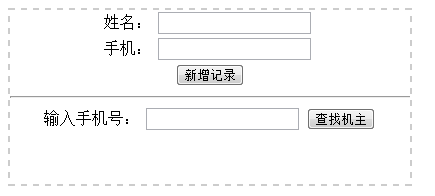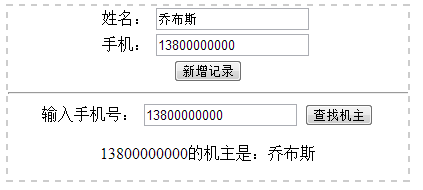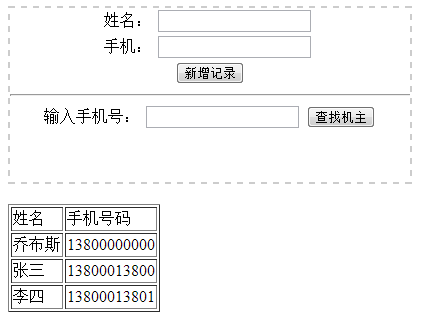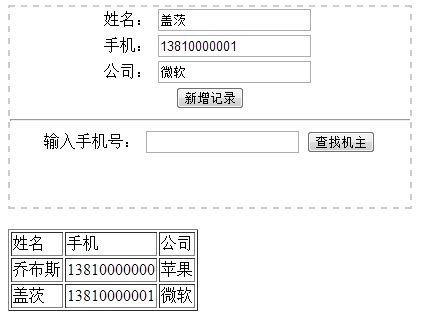Html5web local storage instance details
This article mainlyintroducesHtml5Relevant information about the detailed description of web local storage examples. Friends in need can refer to it
Web Storage is introduced by HTML5 A very important function that can store data locally on the client, similar to HTML4's cookie, but its functions are much more powerful than cookies. The cookie size is limited to 4KB. Web Storage officially recommends that each Website 5MB.
Web Storage is divided into two types:
sessionStorage
localStorage
It can be clearly seen from the literal meaning that sessionStorage saves the data in the session and disappears when the browser is closed; while localStorage always saves the data locally on the client;
No matter it SessionStorage or localStorage, the API that can be used are the same, the commonly used ones are as follows (take localStorage as an example):
Save data: localStorage.setItem (key,value);Read data: localStorage.getItem(key);DeleteSingle data: localStorage.removeItem(key);Delete all data: localStorage.clear ();Get the key of a index: localStorage.key(index);
As above, both key and value must be string, in other words , the web Storage API can only operate on strings.
Next, we develop a simple address book applet through Web Storage to demonstrate the use of relevant APIs; we want to implement the following functions:
Enter contacts, and the contacts have names , mobile phone number 2 fields, use the mobile phone number as the key to store in localStorage; find the owner according to the mobile phone number; list all currently saved contact information;
First write a simple html code
<!DOCTYPEHTML> <html> <head> <metacharsetmetacharset="utf-8"/> <title>HTML5本地存储之WebStorage篇</title> </head> <body> <pstylepstyle="border:2pxdashed#ccc;width:320px;text-align:center;"> <labelforlabelfor="user_name">姓名:</label> <inputtypeinputtype="text"id="user_name"name="user_name"class="text"/> <br/> <labelforlabelfor="mobilephone">手机:</label> <inputtypeinputtype="text"id="mobilephone"name="mobilephone"/> <br/> <inputtypeinputtype="button"onclick="save()"value="新增记录"/> <hr/> <labelforlabelfor="search_phone">输入手机号:</label> <inputtypeinputtype="text"id="search_phone"name="search_phone"/> <inputtypeinputtype="button"onclick="find()"value="查找机主"/> <pidpid="find_result"><br/></p> </p> <br/> <pidpid="list"> </p> </body> </html>
After writing the page, the display effect will be almost as shown below:

To save contacts, you only need to implement it simply The following JS method is enough:
functionsave(){
varmobilephone=document.getElementById("mobilephone").value;
varuser_name=document.getElementById("user_name").value;
localStorage.setItem(mobilephone,user_name);
} //用于保存数据To find the owner, implement the following JS method:
//查找数据
functionfind(){
varsearch_phone=document.getElementById("search_phone").value;
varname=localStorage.getItem(search_phone);
varfind_result=document.getElementById("find_result");
find_result.innerHTML=search_phone+"的机主是:"+name;
}
To display all saved contact information, you need to use the localStorage.key(index) method, as follows:
//将所有存储在localStorage中的对象提取出来,并展现到界面上
functionloadAll(){
varlist=document.getElementById("list");
if(localStorage.length>0){
varresult="<tableborder='1'>";
result+="<tr><td>姓名</td><td>手机号码</td></tr>";
for(vari=0;i<localStorage.length;i++){
varmobilephone=localStorage.key(i);
varname=localStorage.getItem(mobilephone);
result+="<tr><td>"+name+"</td><td>"+mobilephone+"</td></tr>";
}
result+="</table>";
list.innerHTML=result;
}else{
list.innerHTML="目前数据为空,赶紧开始加入联系人吧";
}
}The effect is as follows :

Question: The above demo only has two fields, name and mobile phone number. If you want to store richer contact information, such as company name, family Address, etc., how to implement it? Doesn't Web Storage only handle strings? At this time, you can use the stringify() method of JSON to convert the complex object into a string and store it in Web Storage; when reading from Web Storage, you can use The parse() method of JSON is then converted into a JSON object;
The following is a simple demonstration of adding the contact save JS code of the company attribute :
//保存数据
functionsave(){
varcontact=newObject;
contact.user_name=document.getElementById("user_name").value;
contact.mobilephone=document.getElementById("mobilephone").value;
contact.company=document.getElementById("company").value;
varstr=JSON.stringify(contact);
localStorage.setItem(contact.mobilephone,str);
loadAll();
}
//将所有存储在localStorage中的对象提取出来,并展现到界面上
functionloadAll(){
varlist=document.getElementById("list");
if(localStorage.length>0){
varresult="<tableborder='1'>";
result+="<tr><td>姓名</td><td>手机</td><td>公司</td></tr>";
for(vari=0;i<localStorage.length;i++){
varmobilephone=localStorage.key(i);
varstr=localStorage.getItem(mobilephone);
varcontact=JSON.parse(str);
result+="<tr><td>"+contact.user_name+"</td><td>"+contact.mobilephone+"</td><td>"+contact.company+"</td></tr>";
}
result+="</table>";
list.innerHTML=result;
}else{
list.innerHTML="目前数据为空,赶紧开始加入联系人吧";
}
}The effect is as follows:

The above is a detailed explanation of the Html5 web local storage example introduced by the editor. I hope it will be helpful to you. If you have any questions, please give us I leave a message
The above is the detailed content of Html5web local storage instance details. For more information, please follow other related articles on the PHP Chinese website!

Hot AI Tools

Undresser.AI Undress
AI-powered app for creating realistic nude photos

AI Clothes Remover
Online AI tool for removing clothes from photos.

Undress AI Tool
Undress images for free

Clothoff.io
AI clothes remover

Video Face Swap
Swap faces in any video effortlessly with our completely free AI face swap tool!

Hot Article

Hot Tools

Notepad++7.3.1
Easy-to-use and free code editor

SublimeText3 Chinese version
Chinese version, very easy to use

Zend Studio 13.0.1
Powerful PHP integrated development environment

Dreamweaver CS6
Visual web development tools

SublimeText3 Mac version
God-level code editing software (SublimeText3)

Hot Topics
 1667
1667
 14
14
 1426
1426
 52
52
 1328
1328
 25
25
 1273
1273
 29
29
 1255
1255
 24
24
 H5 Code: Best Practices for Web Developers
Apr 16, 2025 am 12:14 AM
H5 Code: Best Practices for Web Developers
Apr 16, 2025 am 12:14 AM
Best practices for H5 code include: 1. Use correct DOCTYPE declarations and character encoding; 2. Use semantic tags; 3. Reduce HTTP requests; 4. Use asynchronous loading; 5. Optimize images. These practices can improve the efficiency, maintainability and user experience of web pages.
 H5: The Evolution of Web Standards and Technologies
Apr 15, 2025 am 12:12 AM
H5: The Evolution of Web Standards and Technologies
Apr 15, 2025 am 12:12 AM
Web standards and technologies have evolved from HTML4, CSS2 and simple JavaScript to date and have undergone significant developments. 1) HTML5 introduces APIs such as Canvas and WebStorage, which enhances the complexity and interactivity of web applications. 2) CSS3 adds animation and transition functions to make the page more effective. 3) JavaScript improves development efficiency and code readability through modern syntax of Node.js and ES6, such as arrow functions and classes. These changes have promoted the development of performance optimization and best practices of web applications.
 Is H5 a Shorthand for HTML5? Exploring the Details
Apr 14, 2025 am 12:05 AM
Is H5 a Shorthand for HTML5? Exploring the Details
Apr 14, 2025 am 12:05 AM
H5 is not just the abbreviation of HTML5, it represents a wider modern web development technology ecosystem: 1. H5 includes HTML5, CSS3, JavaScript and related APIs and technologies; 2. It provides a richer, interactive and smooth user experience, and can run seamlessly on multiple devices; 3. Using the H5 technology stack, you can create responsive web pages and complex interactive functions.
 H5 and HTML5: Commonly Used Terms in Web Development
Apr 13, 2025 am 12:01 AM
H5 and HTML5: Commonly Used Terms in Web Development
Apr 13, 2025 am 12:01 AM
H5 and HTML5 refer to the same thing, namely HTML5. HTML5 is the fifth version of HTML, bringing new features such as semantic tags, multimedia support, canvas and graphics, offline storage and local storage, improving the expressiveness and interactivity of web pages.
 Understanding H5 Code: The Fundamentals of HTML5
Apr 17, 2025 am 12:08 AM
Understanding H5 Code: The Fundamentals of HTML5
Apr 17, 2025 am 12:08 AM
HTML5 is a key technology for building modern web pages, providing many new elements and features. 1. HTML5 introduces semantic elements such as, , etc., which enhances web page structure and SEO. 2. Support multimedia elements and embed media without plug-ins. 3. Forms enhance new input types and verification properties, simplifying the verification process. 4. Offer offline and local storage functions to improve web page performance and user experience.
 H5: How It Enhances User Experience on the Web
Apr 19, 2025 am 12:08 AM
H5: How It Enhances User Experience on the Web
Apr 19, 2025 am 12:08 AM
H5 improves web user experience with multimedia support, offline storage and performance optimization. 1) Multimedia support: H5 and elements simplify development and improve user experience. 2) Offline storage: WebStorage and IndexedDB allow offline use to improve the experience. 3) Performance optimization: WebWorkers and elements optimize performance to reduce bandwidth consumption.
 Deconstructing H5 Code: Tags, Elements, and Attributes
Apr 18, 2025 am 12:06 AM
Deconstructing H5 Code: Tags, Elements, and Attributes
Apr 18, 2025 am 12:06 AM
HTML5 code consists of tags, elements and attributes: 1. The tag defines the content type and is surrounded by angle brackets, such as. 2. Elements are composed of start tags, contents and end tags, such as contents. 3. Attributes define key-value pairs in the start tag, enhance functions, such as. These are the basic units for building web structure.
 The Building Blocks of H5 Code: Key Elements and Their Purpose
Apr 23, 2025 am 12:09 AM
The Building Blocks of H5 Code: Key Elements and Their Purpose
Apr 23, 2025 am 12:09 AM
Key elements of HTML5 include,,,,,, etc., which are used to build modern web pages. 1. Define the head content, 2. Used to navigate the link, 3. Represent the content of independent articles, 4. Organize the page content, 5. Display the sidebar content, 6. Define the footer, these elements enhance the structure and functionality of the web page.




